Wednesday, March 13, 2013
THE SOUND OF SILENCE
Writing is a solitary occupation at best but I'm feeling especially isolated at the moment. In my last three of four blog posts I've included portions of my current project, a novel about Wyatt Earp in Tombstone, and asked for feedback from readers. I've had two comments, for which I am deeply grateful. But only two? I know I'm obscure but Jeez! You'd think someone might stumble across my website just by accident. Of course it's also possible that folks are indeed checking in--google analytics says they are--but just don't feel the material deserves a critique. That's a disconcerting idea. But hell, that's the writing life. One labors in an echo chamber and hopes in vain to hear something--even a complaint--if only to reassure oneself that one still exists. But enough of self-pity. If all writers were to allow themselves to engage in serious self-pity they would all commit suicide and truly, as well as figuratively, vanish from the scene.
Anyway, today I thought it was time to post another entry, and figured that, if Wyatt Earp is a non-starter, maybe World War Two will draw some notice. I was born in 1938, so I my childhood and the WWII years coincided. It happened that I was fascinated by combat aviation and consequently worshipped every glimpse I could get of a P-51 Mustang or a P-47 Thunderbolt--or, very rarely, the exotic twin-boomed silhouette of the P-38 Lightning. Occasionally one might see a B-17 Flying Fortress or, toward the end of the war, the mighty B-29 Superfortress, so sleek and streamlined it looked like something out of the Space-Age future. I can still hear in my memory the sound a Mustang made as it passed over the Asheville airport at low level--a shrill whistle followed by the thunderous roar of its powerful engine.
But my favorite WWII fighter plane was one I never saw in reality. I could only worship it when it appeared in newsreels and films--the British Supermarine Spitfire, probably the most beautiful fighter plane ever designed, with its elliptical wings, bubble canopy, shapely fuselage and deadly eight machine-guns (or two cannon). This was the plane that, together with its teammate the Hawker Hurricane, won the Battle of Britain and began to turn the tide of the European war toward the Allied cause. I still have a shelf of books on WWII airplanes, through which I occasionally browse reliving my childhood excitement. The other day I found, by accident, a nice color photo of a Spitfire online, and thought I would post it here, so my readers might know that I do have other, more modern interests than Western gunfighters and wayward medieval crusaders. I hope you like it as much as I do.
Subscribe to:
Post Comments (Atom)


As a kid, often at Cattail, I put together plastic models of every single one of the fighter planes and bombers you mentioned above. Oh my that was fun. Thanks for so eloquently sharing your memories of actually seeing and hearing some of these (and I am NOT saying you are an old fart!)
ReplyDeleteBelated thanks for your comment, Worth. I still long for those plastic models of WWII planes I built so long ago. My masterpiece was a B-26 Marauder. Can't account for what happened to it...
Delete